Kristine Hughes's Blog, page 155
March 20, 2011
An Exhibition of Royal Photographers
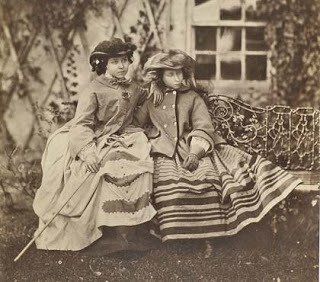 The Princess Royal and Princess Alice, Balmoral 1856 by Fenton
The Princess Royal and Princess Alice, Balmoral 1856 by Fenton
A new exhibition entitled Roger Fenton and Julia Margaret Cameron: Early British Photographs from the Royal Collection, will be on display at The Arts and Crafts House, Blackwell, Cumbria until April 27 2011.
Both Queen Victoria and Prince Albert were photography enthusiasts who kept voluminous photo albums containing pictures of their own family, as well as "art" photographs of models, people and places. At her death in 1901, Queen Victoria's collection numbered an estimated 20,000 photographs. In December of 1853, the Royal Couple attended the inaugural exhibition of the Photographic Society. Roger Fenton, founder of the Society, of which Prince Albert later became a patron, personally showed them the exhibits and was invited to Windsor Castle to photograph royal children, the beginnings of a large collection of photos he'd take of the family. Coincidentally or not, after Prince Albert's death in 1861, Fenton sold his photo equipuipment and gave up photography to retrun to the practice of law and relative obscurity.
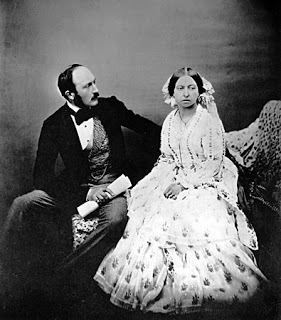 Queen Victoria and Prince Albert, by Fenton, June 30, 1854
Queen Victoria and Prince Albert, by Fenton, June 30, 1854
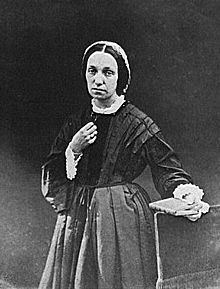 Julia Margaret Cameron (self portrait)
Julia Margaret Cameron (self portrait)
Queen Victoria first saw the work of Julia Margaret Cameron after Albert's death at Colnaghi's photo gallery in London and began collecting her work. Born in 1815, Cameron took up photography in 1863, when her duagher gave her a camera. Within a year, Cameron became a member of the Photographic Societies of London and Scotland. A few of her artistic photographs are show here -
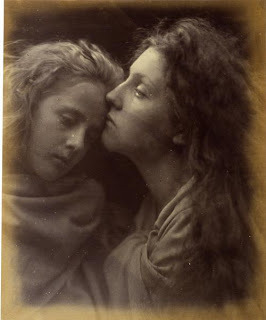 The Kiss of Peace 1869
The Kiss of Peace 1869
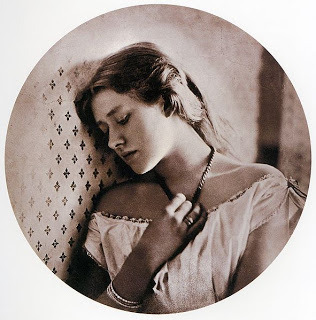 "Sadness" featurning Ellen Terry
"Sadness" featurning Ellen Terry
For further information on photos of the royal family . . .
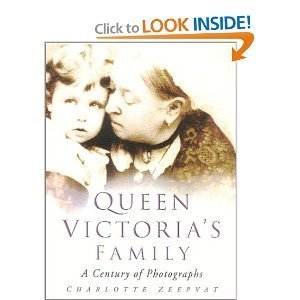

 The Princess Royal and Princess Alice, Balmoral 1856 by Fenton
The Princess Royal and Princess Alice, Balmoral 1856 by Fenton A new exhibition entitled Roger Fenton and Julia Margaret Cameron: Early British Photographs from the Royal Collection, will be on display at The Arts and Crafts House, Blackwell, Cumbria until April 27 2011.
Both Queen Victoria and Prince Albert were photography enthusiasts who kept voluminous photo albums containing pictures of their own family, as well as "art" photographs of models, people and places. At her death in 1901, Queen Victoria's collection numbered an estimated 20,000 photographs. In December of 1853, the Royal Couple attended the inaugural exhibition of the Photographic Society. Roger Fenton, founder of the Society, of which Prince Albert later became a patron, personally showed them the exhibits and was invited to Windsor Castle to photograph royal children, the beginnings of a large collection of photos he'd take of the family. Coincidentally or not, after Prince Albert's death in 1861, Fenton sold his photo equipuipment and gave up photography to retrun to the practice of law and relative obscurity.
 Queen Victoria and Prince Albert, by Fenton, June 30, 1854
Queen Victoria and Prince Albert, by Fenton, June 30, 1854  Julia Margaret Cameron (self portrait)
Julia Margaret Cameron (self portrait)Queen Victoria first saw the work of Julia Margaret Cameron after Albert's death at Colnaghi's photo gallery in London and began collecting her work. Born in 1815, Cameron took up photography in 1863, when her duagher gave her a camera. Within a year, Cameron became a member of the Photographic Societies of London and Scotland. A few of her artistic photographs are show here -
 The Kiss of Peace 1869
The Kiss of Peace 1869  "Sadness" featurning Ellen Terry
"Sadness" featurning Ellen TerryFor further information on photos of the royal family . . .

Published on March 20, 2011 00:16
March 19, 2011
Yale Center for British Art
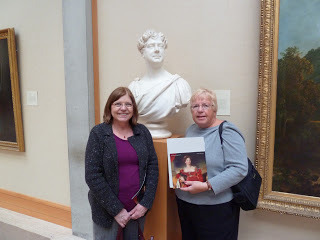 Victoria here. I cannot imagine a place I would rather be (on the U.S. side of the pond, anyway) then the Yale Center for British Art. Think of yourself surrounded by wonderful works by Reynolds, Gainsborough, Stubbs, and many more, not to mention the current exhibition Thomas Lawrence Regency Power and Brilliance. Here are Diane Gaston (l) and me, keeping company with George IV. The bust, in white marble, was sculpted by Sir Francis Chantrey (1781-1841) in the year 1827. To quote the label behind my head: "George IV was greedy, spoiled, manipulative, lecherous, foolish, extravagant, and stubborn. But in his heyday during the Regency period, the king was, perhaps more than any of his Hanoverian predecessors, a bold, daring and brilliant patron of the visual arts and of architecture."
Victoria here. I cannot imagine a place I would rather be (on the U.S. side of the pond, anyway) then the Yale Center for British Art. Think of yourself surrounded by wonderful works by Reynolds, Gainsborough, Stubbs, and many more, not to mention the current exhibition Thomas Lawrence Regency Power and Brilliance. Here are Diane Gaston (l) and me, keeping company with George IV. The bust, in white marble, was sculpted by Sir Francis Chantrey (1781-1841) in the year 1827. To quote the label behind my head: "George IV was greedy, spoiled, manipulative, lecherous, foolish, extravagant, and stubborn. But in his heyday during the Regency period, the king was, perhaps more than any of his Hanoverian predecessors, a bold, daring and brilliant patron of the visual arts and of architecture."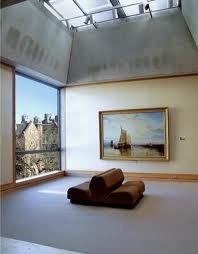 The interior of the YCBA is very comfortable and welcoming. I like a museum where there are lots of seats where one can sit and look at the pictures -- and this gallery has the added advantage of windows to the outside. The picture in the center is by Joseph Mallord William Turner (1775-1851), a work with the kind of realistic detail he later eschewed. It is titled Dordrecht, the Dort Packet-boat from Rotterdam Becalmed painted in 1818. I love almost everything by Turner but this particularly engages me.
The interior of the YCBA is very comfortable and welcoming. I like a museum where there are lots of seats where one can sit and look at the pictures -- and this gallery has the added advantage of windows to the outside. The picture in the center is by Joseph Mallord William Turner (1775-1851), a work with the kind of realistic detail he later eschewed. It is titled Dordrecht, the Dort Packet-boat from Rotterdam Becalmed painted in 1818. I love almost everything by Turner but this particularly engages me.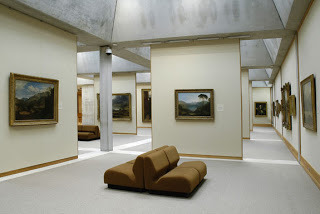 Here is another view of the galleries, photos attributed to Richard Caspole. Although I wouldn't mind being the only patron for a few hours, I must say the place has never been empty when I visited. The building was designed by was Louis I. Kahn (1901-1974), once a professor of architecture at Yale, and a leading American mid-century architect. The YCBA is immediately across the street from the Yale Art Gallery, also designed by Kahn, now undergoing renovations.
Here is another view of the galleries, photos attributed to Richard Caspole. Although I wouldn't mind being the only patron for a few hours, I must say the place has never been empty when I visited. The building was designed by was Louis I. Kahn (1901-1974), once a professor of architecture at Yale, and a leading American mid-century architect. The YCBA is immediately across the street from the Yale Art Gallery, also designed by Kahn, now undergoing renovations.
 My report on that collection will have to await a future trip to New Haven, which is actually on my agenda for 2012. That is, if I can tear myself away from the YCBA.
My report on that collection will have to await a future trip to New Haven, which is actually on my agenda for 2012. That is, if I can tear myself away from the YCBA.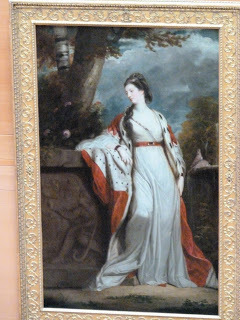 This lovely portrait by Sir Joshua Reynolds shows Elizabeth Gunning, Duchess of Hamilton, later Duchess of Argyll (1758-60). Reynolds (1723-92) was renowned for his portraits of British society ladies, sometimes even depicted with their husbands. He and Thomas Gainsborough competed for prominence and commissions for many years in London. The subject of this painting was one of the famous Irish Gunning sisters, renowned for their beauty in mid 18th c. London. Both married peers of the realm, though the elder sister, Maria, Countess of Coventry (1732-1760), died very young. Elizabeth was the mother of three children from her first marriage and five from her second. Four of her sons were dukes.
This lovely portrait by Sir Joshua Reynolds shows Elizabeth Gunning, Duchess of Hamilton, later Duchess of Argyll (1758-60). Reynolds (1723-92) was renowned for his portraits of British society ladies, sometimes even depicted with their husbands. He and Thomas Gainsborough competed for prominence and commissions for many years in London. The subject of this painting was one of the famous Irish Gunning sisters, renowned for their beauty in mid 18th c. London. Both married peers of the realm, though the elder sister, Maria, Countess of Coventry (1732-1760), died very young. Elizabeth was the mother of three children from her first marriage and five from her second. Four of her sons were dukes.
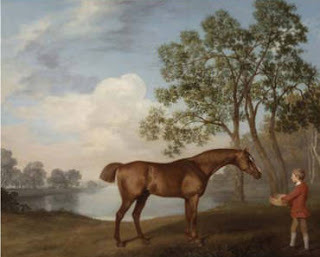 The YCBA has an excellent collection of works by George Stubbs (1724-1806). This picture of Pumpkin with a Stable-lad was one of the first purchases of British art made by Paul Mellon (1907-1999), whose collection is the nucleus of the YCBA. Mellon was particularly fond of sporting pictures and of Stubbs in particular. His father, Andrew Mellon, his uncle and grandfather were the scions of the Mellon Bank and one of America's greatest fortunes. Andrew and Paul Mellon were responsible for the creation of the National Gallery of Art in Washington, D. C. and gave the Andrew Mellon collection as its most important bequest.
The YCBA has an excellent collection of works by George Stubbs (1724-1806). This picture of Pumpkin with a Stable-lad was one of the first purchases of British art made by Paul Mellon (1907-1999), whose collection is the nucleus of the YCBA. Mellon was particularly fond of sporting pictures and of Stubbs in particular. His father, Andrew Mellon, his uncle and grandfather were the scions of the Mellon Bank and one of America's greatest fortunes. Andrew and Paul Mellon were responsible for the creation of the National Gallery of Art in Washington, D. C. and gave the Andrew Mellon collection as its most important bequest.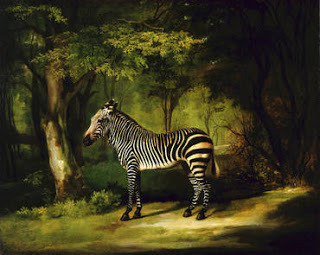 Stubbs was a favorite painter of Paul Mellon, from his racing horses (which reflected Mellon's interest in horseracing) to his exotic animals to his dramatically violent pictures of beasts attacking horses. The view to the left, Zebra, dates from 1762–63. Again, the photo is from the YCBA by Richard Caspole. As Zebra was the name of my former publisher, I have a special fondness for the little fellow.
Stubbs was a favorite painter of Paul Mellon, from his racing horses (which reflected Mellon's interest in horseracing) to his exotic animals to his dramatically violent pictures of beasts attacking horses. The view to the left, Zebra, dates from 1762–63. Again, the photo is from the YCBA by Richard Caspole. As Zebra was the name of my former publisher, I have a special fondness for the little fellow.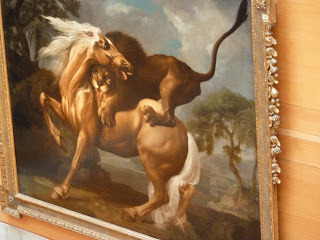
Equally beautiful but shockingly violent is the 1762 painting Lion Attacking a Horse, one of several such views Stubbs painted after supposedly witnessing a similar event while traveling abroad. I guess it makes the scene even more upsetting to us to note that the horse looks much like Trigger.
Paul Mellon graduated from Yale University and was the major benefactor for the YCBA, both the building and the collection.
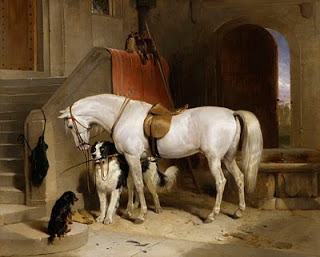
Continuing the horsey theme with a more mellow view, this painting by Edward Landseer (1802-1873) depicts The Favourites, the property of H.R.H. Prince George of Cambridge, as seen in 1834-5. Landseer had a way with animals, didn't he?
A love for horses and British art are probably the only qualities I share with the late Paul Mellon, but I certainly appreciate his taste and his philanthropy. The Virginia Museum of Fine Arts in Richmond, VA, has also benefited from the Mellon's donations of British Sporting Art.
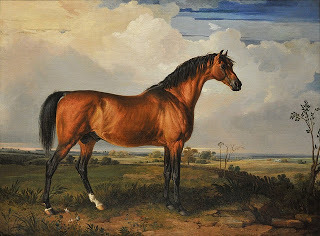
At right is Eagle, A Celebrated Stallion, by James Ward (1769-1859) painted in 1809.
According to the YCBA, the picture "exhibits Ward's remarkable ability to create an accurate physical portrayal of a particular animal. He also evokes a transcendent romantic type suggesting the latent power of the barely tamed creature is full of drive, dash, and tension..." As you may have guess, I am a bit horse-crazy myself. Though, looking at these magnificent specimens, who isn't?
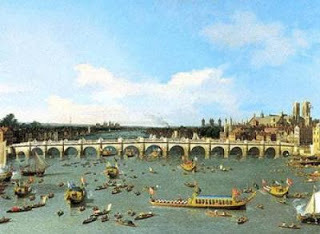 Finally, here are two paintings of London by the renowned Venetian master Giovanni Antonio Canal, known as Canaletto (1697–1768). Before Diane and I visited Yale in early March, we spent the first day of the month with our pals Julie and Carol at Washington's National Gallery to see the exhibition Canaletto and His Rivals, about which I will post soon. Canaletto was a great favorite of traveling British aristocrats and he came to London for a few years and painted many local scenes. Though I must say I wonder if the boats on the Thames looked quite so much like the gondolas and barges of his home town.
Finally, here are two paintings of London by the renowned Venetian master Giovanni Antonio Canal, known as Canaletto (1697–1768). Before Diane and I visited Yale in early March, we spent the first day of the month with our pals Julie and Carol at Washington's National Gallery to see the exhibition Canaletto and His Rivals, about which I will post soon. Canaletto was a great favorite of traveling British aristocrats and he came to London for a few years and painted many local scenes. Though I must say I wonder if the boats on the Thames looked quite so much like the gondolas and barges of his home town.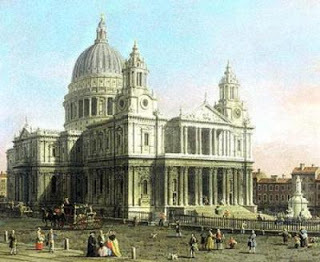 St Paul's Cathedral by Canaletto, at right. The Italian artist lived in London from 1746 to 1755 and painted many views of England, probably none more magnificently than this. The cathedral, designed by Sir Christopher Wren in a nearly-Italian baroque style, had been finished in 1710, after its predecessor had been destroyed in the Great Fire of London in 1666. It must have looked much more familiar to the Venetian Canaletto than other, gothic-style London churches.
St Paul's Cathedral by Canaletto, at right. The Italian artist lived in London from 1746 to 1755 and painted many views of England, probably none more magnificently than this. The cathedral, designed by Sir Christopher Wren in a nearly-Italian baroque style, had been finished in 1710, after its predecessor had been destroyed in the Great Fire of London in 1666. It must have looked much more familiar to the Venetian Canaletto than other, gothic-style London churches. Coming soon, a visit to Yale's Beinecke Rare Book and Manuscript Library...and more Canaletto from Washington, D.C.
Published on March 19, 2011 02:00
March 18, 2011
On The Shelf - Discovering New Authors - Part Five
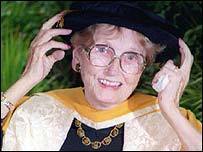 Prolific author Dame Catherine Cookson died in 1998, just nine days short of her 92nd birthday. She had rarely been out of the top ten most-borrowed books in British public libraries, and in 1997, for the second year running, nine out of ten out of the most popular library books borrowed were written by Dame Catherine. Accroding to a February 2010 article in The Guardian: "She dominated the library charts for years – but there is no trace of her among the 100 most borrowed books of 2008-9. She is still, however, the 10th most borrowed author of the decade."
Prolific author Dame Catherine Cookson died in 1998, just nine days short of her 92nd birthday. She had rarely been out of the top ten most-borrowed books in British public libraries, and in 1997, for the second year running, nine out of ten out of the most popular library books borrowed were written by Dame Catherine. Accroding to a February 2010 article in The Guardian: "She dominated the library charts for years – but there is no trace of her among the 100 most borrowed books of 2008-9. She is still, however, the 10th most borrowed author of the decade."Cookson was born illegitimate in 1906 to an alcoholic mother and grew up in poverty around the towns of Shields and Jarrow in County Durham, now Tyne and Wear, the setting for most of her books. She would use the people, places and experiences of her childhood to draw sypmathetic characters and compelling plotlines that touched many a reader's heart. A few weeks before her 84th birthday, a Sunday newspaper named her as Britain's 17th richest woman with an estimated fortune of £14 million. And in her kindness, Cookson has left each of us a legacy - her impressive backlist of over 100 books, many of which are sagas that follow a single family through darkness and into the light.
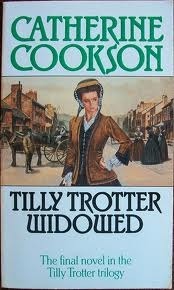
Oh, how I love Cookson's books. To describe them, and their effect upon the reader, is to dredge up every trite and hackneyed reviewer's phrase: like curing up wth an old friend, the perfect book for a cold winter's day, a compelling and moving story, etc., etc., etc. However, in Cookson's case, these platitudes are quite true. No matter how dire consequences become for Cookson's characters, we know that all will come right in the end and the journey is pure entertainment.
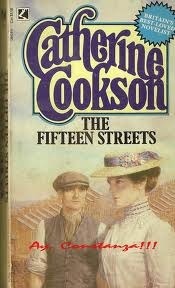
The following cover blurbs will give you the flavour of Cookson's novels -
The Fifteen Streets - Life in the Fifteen Streets was a continual struggle for survival. Some families gave up hope and descended into a state of perpetual despair. Others, like the O'Briens, maintained a fierce determination to transcend the bitter poverty into which they had been born. For Mary Ellen O'Brien, hope lay in the wisdom and strength of her children. There was gentle Katie, whose bright beauty and quick mind led her to a new world of learning; Dominic, fast-tempered and strong-willed; and there was John--the most determined to escape the cruel poverty of the Fifteen Streets, the most passionate, courageous and loving of all the O'Briens.
Kate Hannigan - Dr Rodney Prince has never seen a girl who looked more out of place in the grime and squalor of the Fifteen Streets than did Kate Hannigan. He knew she had suffered at the hands of men: Tim Hannigan, her 'father', was a vicious bully; John Herrington, a smooth-talking seducer, had left her with his child. But Rodney Prince's desire for a family had been frozen out by a wife who'd wanted Harley Street, not a Tyneside slum. By contrast, Kate glowed with a warmth that far outshone the hard, brittle beauty of Stella and exposed the emptiness in his heart. And so, between Rodney Prince, a wealthy man locked in an unhappy marriage, and Kate Hannigan, a bastard child of the slums, grew a love that opposed all the concepts of an Edwardian society.
The Tide of Life - Sep McGilby said Emily Kennedy has a glad face. And at 16, Emily had a lot to be glad about. She loved her job as a maid-of-all-work to the McGilby's, and the only cloud of her horizon was her anxiety about her delicate, younger sister Lucy. But when the invalid Mrs McGilby died, and Sep was killed in an accident soon after, Emily and Lucy were forced to leave South Shields to look for work. The household of Croft Dene house, where Lawrence Birch ruled as master, was a strange one, and as Emily became more deeply involved with the family's affairs, she grew rapidly from girl to woman, needing all her strength of will and character to get her through. And whatever happened, she clung grimly to a scrap of philosophy that had become her motto: 'Never say die!'
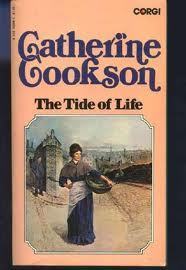
You'll find a complete bibliography of Cookson's books at Fantastic Fiction.
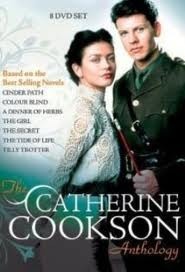
Many of Cookson's novels have been made into films, the first being The Fifteen Streets staring Shean Bean and Owen Teale, which was nominated for an Emmy in 1990. Having seen a few of these productions, I can tell you that something is definitely lost in the translation and that Cookson was simply meant to be read. And felt.
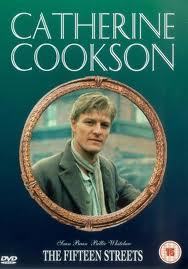
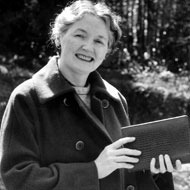
Cookson left the North East for Hastings in 1929 where she worked in a laundry. She spent forty six years in Hastings, where she met and married schoolmaster Thomas Cookson. You can read an interesting story about her home in Hastings here.
To read more about the author and her life, we suggest
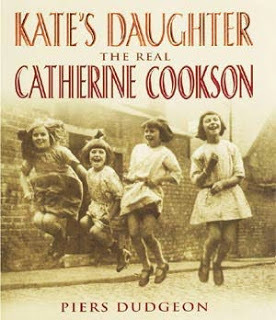
Published on March 18, 2011 00:43
March 17, 2011
Happy Birthday to Number One London!


Snaps of our Year
It's hard to believe that Number One London is a year old today. And what a year it's been - we've seen over 57,000 visitors from across the globe, many of whom are loyal readers, with top countries including the US, UK, Canada, Germany, Australia, France, Spain, Sweden, Poland and India. Number One London is being read in such diverse locales as Israel, Iceland, Armenia, Sri Lanka, Mongolia, Uganda, Fiji and the Faroe Islands - a subarctic island group situated approximately halfway between Great Britian and Iceland.
To date we've published over 400 posts and have been fortunate enough to win a few awards. Personally, Victoria and I have had a blast blogging, sharing and hearing from all of you. Thanks so much for your comments and emails and for sharing links to Number One London with your friends. Thanks to those with blogs and websites of their own who have been kind enough to include our link on their pages and thanks to those who have joined us as Followers. If you haven't yet, please do - we're already up to 82!
And lest we forget . . . .
Happy St. Patrick's Day!
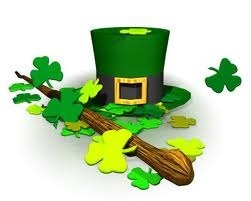
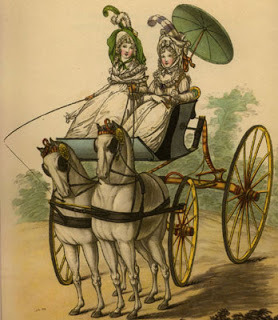 Victoria here, adding my two cents...I don't claim to be an expert on various methods of getting high...whether in a high perch Phaeton or with some controlled substance or whatever suits your fancy. I DO know how to get high on blogging, however. It's easy -- find a subject you want to know more about or an experience you want to share and let yourself GO. I disappear into the computer-world of Google and My Pictures and fabulous websites. And sometimes I even look at -- hold your breath a moment -- books. This process of getting high involves varying stages of consciousness and actions otherwise known at HUNTING, CREATING and FULFILLMENT...well, not always fulfillment, as some efforts fall short of our aspirations. But even then, the attempt is almost always amusing. Perhaps you have to be some sort of a research nut or book freak, but whatever turns you on, as they say.
Victoria here, adding my two cents...I don't claim to be an expert on various methods of getting high...whether in a high perch Phaeton or with some controlled substance or whatever suits your fancy. I DO know how to get high on blogging, however. It's easy -- find a subject you want to know more about or an experience you want to share and let yourself GO. I disappear into the computer-world of Google and My Pictures and fabulous websites. And sometimes I even look at -- hold your breath a moment -- books. This process of getting high involves varying stages of consciousness and actions otherwise known at HUNTING, CREATING and FULFILLMENT...well, not always fulfillment, as some efforts fall short of our aspirations. But even then, the attempt is almost always amusing. Perhaps you have to be some sort of a research nut or book freak, but whatever turns you on, as they say.
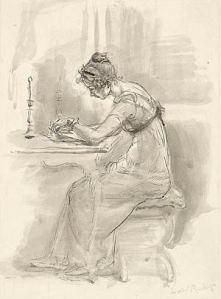 Despite the fact that I am hunched over a laptop or balancing an iPad on my knees, I see myself as the figure at left, a wonderful sketch by Isabel Bishop (1902–1988), A Scene from Pride and Prejudice.
Despite the fact that I am hunched over a laptop or balancing an iPad on my knees, I see myself as the figure at left, a wonderful sketch by Isabel Bishop (1902–1988), A Scene from Pride and Prejudice.The drawing was used in the Morgan Library's excellent exhibition on Jane Austen, and I am sure it looks just like her. Or me. Or Kristine. Or maybe, you???
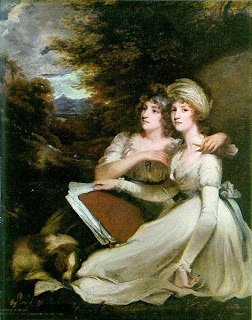 And just to add a little more to the fantasy, here is a picture of Kristine and me, cleverly anticipated by John Hoppner. Don't believe a word of that info that says they are the Frankland Sisters, because that's just a rumor perpetrated by Washington's National Gallery of Art. In fact, Kristine and I can often be found together in exactly this same pose. The folder between us contains just a portion of our voluminous collection of Wellington research. As neither of us owns a dog, we're at a loss as to where this one came from . . . . .
And just to add a little more to the fantasy, here is a picture of Kristine and me, cleverly anticipated by John Hoppner. Don't believe a word of that info that says they are the Frankland Sisters, because that's just a rumor perpetrated by Washington's National Gallery of Art. In fact, Kristine and I can often be found together in exactly this same pose. The folder between us contains just a portion of our voluminous collection of Wellington research. As neither of us owns a dog, we're at a loss as to where this one came from . . . . . Soon I will be off on new flights of fancy and travel adventures and indulging in more highs originating in the 18th and 19th centuries. All brought to you by the wizardry of 21st century technology. Because I prefer indoor plumbing and other creature comforts, I am probably better off living in the 21st century, but my head is often several hundred years behind...because I wish it so.
Thanks to all of you who join us in this endeavor especially to our guest bloggers and good friends who comment. The more the merrier.

Published on March 17, 2011 02:08
Windsor Museum Finds New Home
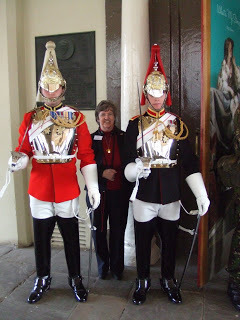
The Windsor and Royal Borough Museum has just relocated to its new home at the Guildhall in Windsor. Above is a photo of our good friend, author Hester Davenport, with two dashing opening attendees. You may recall that Hester gave Victoria and I a personally guided tour round Windsor when we were there in June. If not, you can refresh your memory by revisiting that post here.
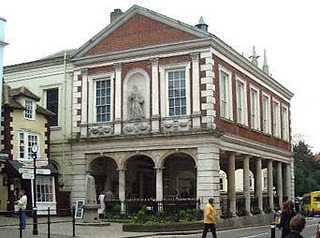 The Guildhall, Windsor. Note the "crooked house"
The Guildhall, Windsor. Note the "crooked house" butting up against the Guildhall at left.The Museum is 'small but perfectly formed', with displays of artefacts from the earliest times, including everything from a mammoth's tooth and mastodon's tusk to objects and ephemera from before Victorian times up to World War II, the 1950s and the present day. In addition, visitors will find lots of interactive displays and a photo-opportunity to get stuck in the pillory and pelted with fruit and veg (the cuddly sort). And, as Hester is quick to remind me, the opportunity to see the very room in which Prince Charles and Camilla wed (staff availability depending).
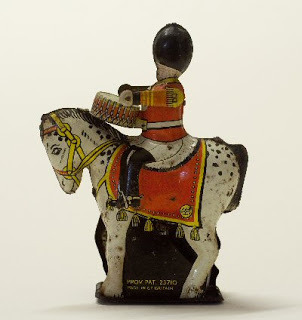
The Museum is open Tuesday - Saturday 10 am to 4 pm and on Sundays from 12-4. You can visit the Museum website here, and you can see pictures of the Musuem and part of its collections here.
Published on March 17, 2011 02:00
March 16, 2011
Magnificence at Yale, Part Three
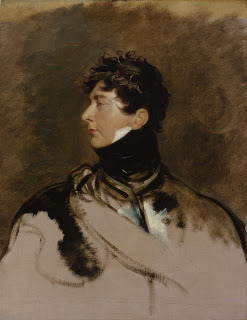 I decided to do a separate blog about what I will call the POWER portraits of the exhibition now at the Yale Center for British Art in New Haven CT. It will be on view until June 5, 2011, the second and last venue, so if you can possibly make it there, you will be richly rewarded. Part two, posted on 3/12/11, could have been called BRILLIANCE. What poured out of me in the 3/8/11 post covered the things that caught my eye first off. You see, a perfectly rational way to divide up the spoils of this excellent exhibition....
I decided to do a separate blog about what I will call the POWER portraits of the exhibition now at the Yale Center for British Art in New Haven CT. It will be on view until June 5, 2011, the second and last venue, so if you can possibly make it there, you will be richly rewarded. Part two, posted on 3/12/11, could have been called BRILLIANCE. What poured out of me in the 3/8/11 post covered the things that caught my eye first off. You see, a perfectly rational way to divide up the spoils of this excellent exhibition.... To the right is Lawrence's view of Prince George as Prince Regent, painted about 1814. George was florid, overweight, dissolute, and flabby, but not in this view, one of the most egregious of Lawrence's flatteries. It is in London's National Portrait Gallery; some observers say that it is unfinished because it was a study for a coin or a medal, a project which never came to fruition. I'll bet George loved it, for he looks young and vital.
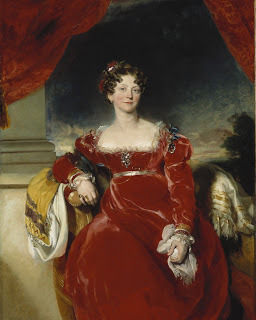
George's sister, Princess Sophia (1777-1848) was never married, though it is generally accepted that she had a child out of wedlock. The father may have been her father's equerry, Thomas Garth. Others, perhaps with political motives, said the father of her child was her brother the Duke of Cumberland.
As one of the six daughters of King George III and Queen Charlotte, Princess Sophia's life was constrained by the demands of her parents and court life. She could not see much of her lover, whoever he was. Not a life I would wish on anyone. In this brilliant red dress, at age 48, I can almost feel her flirting with Lawrence as she sat for him. He was quite the ladies' man, having had many flirtations with princesses, actresses, titled married ladies and others, but none of his relationships grew into marriage. On the other hand, he also was very close to some of his male sitters, leading to occasional suspicions in another direction. For more on his love life,see Jo Manning's posts here on January 8, 9, and 10, 2011.
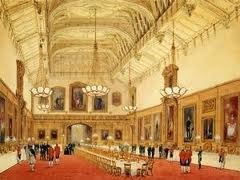
The Prince Regent knighted Sir Thomas Lawrence in 1815, about the same time as he commissioned the artist to travel around Europe and paint grand portraits of the victorious allied leaders in the war against Napoleon. Certainly this was one of the greatest royal commissions for one artist, and the result was suitably magnificent. Several of the paintings below were shown only at the London venue of this exhibition, but since I had seen them in situ at the Waterloo Chamber in Windsor Castle just last summer, I could forgive the Royal Collections for having kept them on their side of the pond. Above, the Waterloo Chamber painted by Joseph Nash in 1844.
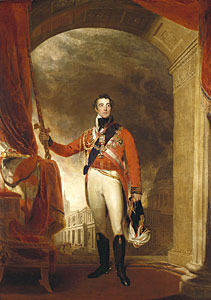
In the upper center of the far wall is this painting of the Duke of Wellington who led the allied troops in the Battle of Waterloo, June 18, 1815. This painting is not in the exhibition, but it has been reproduced so often that it is bound to be familiar. Like the watercolor of the chamber, above, and most of the other heroes below, it belongs to Her Majesty Queen Elizabeth II.
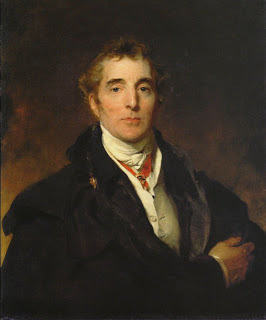
This is the portrait of the Duke to be seen in the New Haven exhibition. I must say I had to drag Diane Gaston away from him; she was sure he was about to speak to her.
This portrait, part of a private collection, was painted in 1820-21, and according to the catalogue, engraved more than any other of Lawrence's works of Wellington. It was commissioned by the Duke's close friends, Charles and Harriet Arbuthnot. Mrs. A is quoted in the catalogue: "It is more like him than any picture I ever saw of him and quite different. All other pictures of him depict him as a hero; this has all the softness and sweetness of countenance which characterises him when he is in the private society of his friends. As a painting, it appears to me : the tone of coloring is so rich. The cloak is just as the Duke wears it, and the hand is remarkably like."
Three of the portraits from the Waterloo Chamber were hung in the London venue of Thomas Lawrence: Regency Power and Brilliance. You will not find them at Yale, but there are several Yale portraits that were not in London, just in case you were wondering.
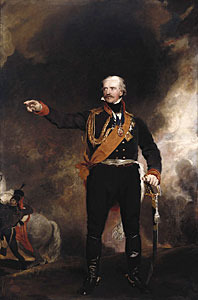 Field Marshal Gebhardt von Blucher (1742-1819) commanded the Prussian forces that cinched the Allied victory at Waterloo. He was a courageous and forceful officer
Field Marshal Gebhardt von Blucher (1742-1819) commanded the Prussian forces that cinched the Allied victory at Waterloo. He was a courageous and forceful officer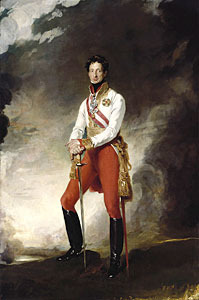 Charles, Archduke of Austria (1771-1847) was painted in 1819 in Vienna. He led the Austrian armies in many battles in which he proved his abilities as a strategist, though he both won and lost against Napoleon during his army career. He was also a distinguished patron of the arts, and Lawrence reportedly enjoyed his companionship.
Charles, Archduke of Austria (1771-1847) was painted in 1819 in Vienna. He led the Austrian armies in many battles in which he proved his abilities as a strategist, though he both won and lost against Napoleon during his army career. He was also a distinguished patron of the arts, and Lawrence reportedly enjoyed his companionship.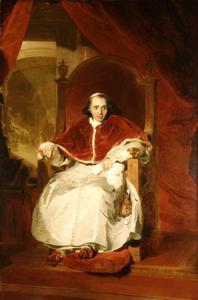 Lawrence made his first visit to Rome in 1819 to paint Pope Pius VII (1742-1823). This is often admired as the finest portrayal of the Waterloo portraits, an particular achievement, says the catalogue, when one thinks of the brilliant artists who portrayed popes in the past. Names such as Raphael, Velazquez, Michelangelo, David and many others must have been in Lawrence's mind as he worked.
Lawrence made his first visit to Rome in 1819 to paint Pope Pius VII (1742-1823). This is often admired as the finest portrayal of the Waterloo portraits, an particular achievement, says the catalogue, when one thinks of the brilliant artists who portrayed popes in the past. Names such as Raphael, Velazquez, Michelangelo, David and many others must have been in Lawrence's mind as he worked.A close examination of the portrait reveals the word PAX on the pope's throne and classical statues from the Vatican collection in the background.
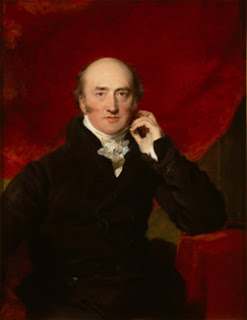 Throughout his career, Lawrence was called on to paint many political leaders of all persuasions in England. We have already seen Lord Liverpool in my post of 3/8/11. And many of his portraits were of business leaders or scientific personages -- but he certainly had more than his share of parliamentary leaders and party spokesmen sitting for him. At right is George Canning (1770-1827), in a portrait completed in 1822 when he was Foreign Secretary. He served briefly as Prime Minster in 1827 and died in office.
Throughout his career, Lawrence was called on to paint many political leaders of all persuasions in England. We have already seen Lord Liverpool in my post of 3/8/11. And many of his portraits were of business leaders or scientific personages -- but he certainly had more than his share of parliamentary leaders and party spokesmen sitting for him. At right is George Canning (1770-1827), in a portrait completed in 1822 when he was Foreign Secretary. He served briefly as Prime Minster in 1827 and died in office.In September, 1809, when Canning was Foreign Secretary, he and Lord Castlereagh disagreed so violently over the disastrous Walcheren Expedition that they fought a duel on Putney Heath. Neither waas injured. As Foreign Secretary from 1812 to 1821, Lord Castlereagh represented Britain at the Congress of Vienna and was painted by Lawrence himself. After Castlereagh, who had inherited the title of 2nd Marquess of Londonderry by then, committed suicide in 1821, Canning succeeded him as Foreign Secretary again. The Londonderry title went to Castlereagh's half-brother, Charles William (Vane-) Stewart, later 3rd Marquess of Londonderry, whose portrait by Lawrence is in this exhibition (see post of 3/12/11).
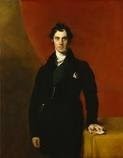 George Hamilton-Gordon, 4th Earl of Aberdeen (1784–1860), is the subject of one of Lawrence's last portraits. He was Prime Minister from 1852 to 1855. The catalogue says the portrait, partly unfinished, "won widespread praise" when it was exhibited after Lawrence's death. Painted in 1829-30, it seems to foreshadow the future success of Lord Aberdeen.
George Hamilton-Gordon, 4th Earl of Aberdeen (1784–1860), is the subject of one of Lawrence's last portraits. He was Prime Minister from 1852 to 1855. The catalogue says the portrait, partly unfinished, "won widespread praise" when it was exhibited after Lawrence's death. Painted in 1829-30, it seems to foreshadow the future success of Lord Aberdeen. After a brief illness, Lawrence died on 7 January, 1830. His body lay in state at the Royal Academy before his funeral at St. Paul's Cathedral, where he is buried in the crypt. Below, a watercolor of the funeral by J. M. W. Turner, 1830, belonging to the Tate Britain (not in the exhibition).
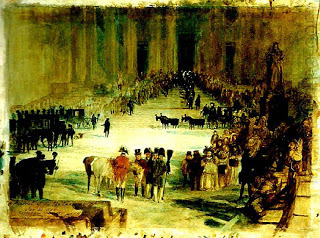
This is the third of my posts on Thomas Lawrence Regency Power and Brilliance, at the Yale Center for British Art in New Haven, CT. It will be on display until June 5, 2011. Soon we will have other posts on our jaunt to Yale. I wish everyone who visits Number One London could have come along. Thanks again to all the wonderful people at Yale, especially Kaci Bayliss and Amy McDonald.
Published on March 16, 2011 02:00
March 15, 2011
London's Notable Black Citizens by Guest Blogger Nina Davis
Born in 1970 deep in the heart of Fort Worth, TX, Nina Caron Davis (that's NEE-nah ka-ROAN) knew from birth she had one mission in life: to add as many gray hairs to her parents' heads as possible. She wasn't a bad girl, but being both a teacher's kid and a preacher's kid destined her to be a bit, well, different.
As a child, she got in trouble for reading in school. Apparently her math teacher didn't feel Judy Blume was appropriate to the class' subject. She's still a book maven. She's also a big fan of anime, dolls Barbie, cornhusk and ball-jointed, loves all kinds of music from Beethoven to ZZ Top, and faithfully practices her home state's religion, Football Fanaticism (go Cowboys!). She also includes genealogy as a hobby.
In real life, she earned her B. A. in English Arts from Hampton University and her M.L.I.S. from the University of Texas at Austin. She is currently a librarian for a public library in the Dallas-Fort Worth Metroplex.
Her first taste of writing came through poetry. In 1994, her poem, "Starry Night," was published in the anthology Dark Side of the Moon. In 1995, she combined her love of the English Regency with her research into the history of Blacks in Britain, winning the Virginia Romance Writers' 7th Annual Fool For Love First Chapter Contest in the Historical/Regency category. The Georgian-era short story "A Singular Woman" was published in the anthology A Regency Sampler in 1999. She currently writes anime-based fan fiction, occasionally brushes off a manuscript, and reviews romance and urban fantasy for the American Library Association's Booklist.
Nina's guest post:
I once had a dream, as I devoured Regency romance after Regency romance in my college years. Or more accurately a question. Could I write a Regency with a heroine who was Black? It was born perhaps from being a child of the '70's who remembered the momentous day she first saw a Black actor in a tooth paste ad, as though Madison Avenue had finally realized we used such products too. And also, perhaps, because of a seed planted by a college history class that spoke of Lord Dunmore's promise to take slaves who fought the British back to England in victory, but never knowing what ever came of it. The research began telling its own stories. Of Queen Elizabeth I's unenforceable decree to remove "blackamoors" from England to ease the burden of the poor on the country. Of Black courtiers taken from Portuguese vessels in King James IV Scottish court, including the Black Lady of the Tournament of the Black Knight and Lady. How Lord Dunmore's promise indeed landed many Black soldiers, not unlike other soldiers without family returning from war, into London's poorer streets. Of African princes education at university, of shopkeepers who left behind their own unique vision of England's middling class. Of the blurring free Black and slave within England itself, highlighted by the tales of Mary Hylas, stolen from her husband because her former masters changed their mind about her freedom, and the famous Somerset Case, a cornerstone in the fight to abolish slavery, presided over by James Murray, Lord Mansfield and Chief Justice. Of Lord Mansfield's own unique brush with race within his own household. Of a queen whose own reflection buoyed a cause and spoke to how intertwined we all truly are.
I have yet to manage the Regency novel. I did manage a Georgian short story, but more than that began an eternal obsession with all things Black in Britain (and in other parts of Europe for that matter). I claim not so much to be an expert as an enthusiast, but like all enthusiasts can't help but to talk a bit about a favored subject, one to underscore why I like keeping the idea of Black History Month, and not trying to relegate it to African-American History Month or dismiss it altogether, because there's so much more to the story than ever happened on American shores.
Many books have been written on the history, the social mores – a fascinating blend of class and race that resembled more 20th-century America's struggles with such than the oversimplified, misapplied stereotype of a pre- and post-antebellum South -- never mind trying to squeeze it into a single blog. So I'll spotlight some notable men and women, focusing on the Georgian, Regency and Victorian eras. A list of books follows for those who may want to indulge their own curiosity further.
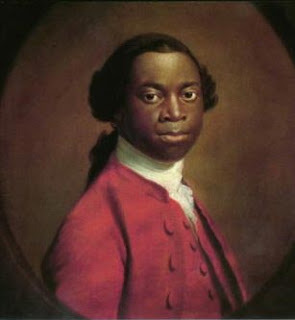
Olaudah Equiano, c. 1745-1797, Anti-slavery Activist
Kidnapped from what is now Nigeria and sold into slavery in childhood, he was a slave to a Royal Navy captain and a Quaker merchant before earning the price of his own freedom. He then traveled the world, including in an aborted attempt to reach the North Pole. Coming to London, he became involved in the abolitionist movement which led to his writing and publishing his famous autobiography, The Interesting Narrative of the Life of Olaudah Equiano, or Gustavus Vassa the African (1789), considered to be the first known English account by an African on his native country.
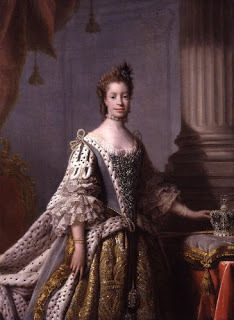
Queen Charlotte Sophia, 1738-1820, Consort of King George III
Let us be clear, Her Majesty was not Black in the sense of one being born of direct or mildly mixed heritage, but of one born of European ancestry long before her birth mingled with African ancestry by way of Margarita de Castro y Sousa of Portugal, genes then so closely interbred in the noble houses of Europe that she was born as if she were. Her "negroid features" were remarked upon by contemporaries and likely used as a symbol by some in the anti-slavery movement. Sir Allan Ramsay, an abolitionist himself, was the artist responsible for the majority of her portraits and his representations of her were the most decidedly African. He also married the niece of Lord Mansfield and was therefore related by marriage to Dido Elizabeth Belle.
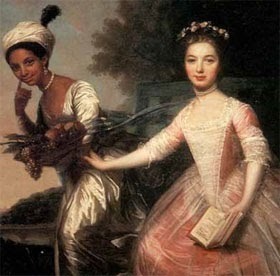
Dido Elizabeth Belle, aka Elizabeth Lindsay, Daughter of Gentry, c. 1763-1804
No record exists of what Dido thought of her uncle's landmark slave case. But surely some of the ramifications crossed her mind as she went about tending the chickens and what other genteel chores were hers in Kenwood, his country estate. She was born of a woman taken from a Spanish vessel by the man who ultimately sired her, Captain Sir John Lindsay of the Royal Navy, Mansfield's nephew. Her very existence in his home became a prism of attitudes of the day, some merely noting her presence as point of description, American visitors noting in surprise when she joined the family after dinner. Scholars have argued whether she was tolerated or beloved family. It was ironic that her great-uncle, in spite of his verdict, felt the need to reiterate her status as a free woman in his will, in which he also left her £500 plus £100 per year. This in addition to the £1000 her father had left her in his will. Other evidence suggests as well that she was indeed a loved family member who was treated as any other "poor relation" would have been. In 1794 she's shown to have married John Davinier, possibly a steward.
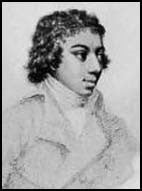
George Augustus Polgreen Bridgetower, Violinist, c. 1779-c. 1840
Born in east Poland, Bridgetower debuted in Pairs at the age of nine, playing a violin concerto by Giornovichi. Soon after he was taken to England by his father and performed in concert. However, many in Society felt the senior Bridgetower mistreated his son, and in 1791, the Prince of Wales (later George IV) paid the father to leave the country. From that point, Bridgetower was under royal protection. For 14 years he was first violinist in the prince's private band. He became friends with Ludwig van Beethoven in 1803 while on concert tour in Austria. He accompanied Beethoven in the first public performance of Violin Sonata no. 9, later known as the Kreutzer Sonata, having never seen the piece before. It was originally dedicated to Bridgetower, but the dedication was changed after the two quarreled. He was elected to the Royal Society of Musicians in 1807 and would later perform with the London Philharmonic Orchestra.
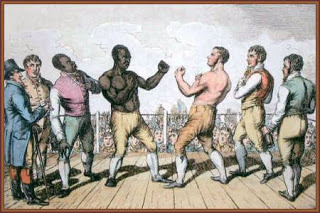
Tom Molineux (or Molyneux), 1784-1818, Renowned Boxer
The first American to fight for the London Prize Ring championship, Molineux was a slave who was reportedly given his freedom after winning a match on which his owner had placed a large bet. He sailed to England in 1809 to become a professional prize fighter. In London, he met another black American, Bill Richmond, a former boxer who became his trainer. He fought his way up the ranks, eventually meeting the British champion, Tom Cribb, on December 18, 1810. He seemed to be winning handily, and in the 23rd round he apparently knocked out Cribb. However, Cribb's corner claimed he had been fouled, and the long argument that ensued gave the champion a chance to regain his senses. Cribb eventually won by knockout in the 33rd round. It was later discovered at one point in the 30th round Molineux had fractured his skull.
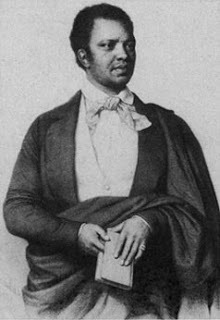
Ida Frederick Aldridge, Shakespearean Actor, 1805-1867
Born in New York City, Aldridge moved to England in the 1820's and studied acting. Despite setbacks early in his career in London due to racism, he became famous across Europe for his leading roles in Shakespearean plays including King Lear, Macbeth and Othello (pictured). He returned from his European tours so loaded with honor even the London West End stage could no longer exclude him and he finally played the famed Lyceum. In 1858, Aldridge became the first actor to be knighted when he was bestowed the Royal Ernestinischen House Order by Duke Bernhard of Saxe-Meiningen (now part of Germany) becoming Chevalier Ira Aldridge, Knight of Saxony.
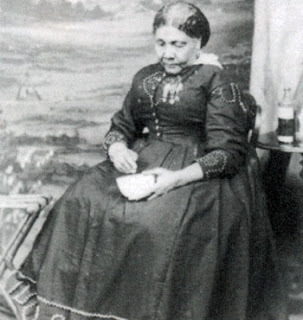
Mary Seacole, 1805-1881, "the Black Florence Nightingale"
A native of Kingston, Jamaica, she learned her nursing skills from her mother who kept a boarding house for invalid soldiers and from trips with her husband to mainland America and England. In 1854, she asked the English war office to be sent as an army nurse to the Crimea. Because of her ethnicity she was refused. Undaunted she funded her own trip to the Crimea where she established the British Hotel, an officers' convalescence hospital, near Balaclava. On the battlefield she nursed the wounded and was known as "Mother Seacole."
Further Reading
Freyer, Peter. Staying power: the history of Black people in Britain, 1984, fifth printing 1991.Gerzina, Gretchen. Black England: life before emancipation, 1995.Lorimer, Douglas A. Color, class and the Victorians, 1978.Scobie, Edward. Black Britannia, 1972.Walvin, James. Black and White: The Negro in English Society, 1555-1945, 1973.
As a child, she got in trouble for reading in school. Apparently her math teacher didn't feel Judy Blume was appropriate to the class' subject. She's still a book maven. She's also a big fan of anime, dolls Barbie, cornhusk and ball-jointed, loves all kinds of music from Beethoven to ZZ Top, and faithfully practices her home state's religion, Football Fanaticism (go Cowboys!). She also includes genealogy as a hobby.
In real life, she earned her B. A. in English Arts from Hampton University and her M.L.I.S. from the University of Texas at Austin. She is currently a librarian for a public library in the Dallas-Fort Worth Metroplex.
Her first taste of writing came through poetry. In 1994, her poem, "Starry Night," was published in the anthology Dark Side of the Moon. In 1995, she combined her love of the English Regency with her research into the history of Blacks in Britain, winning the Virginia Romance Writers' 7th Annual Fool For Love First Chapter Contest in the Historical/Regency category. The Georgian-era short story "A Singular Woman" was published in the anthology A Regency Sampler in 1999. She currently writes anime-based fan fiction, occasionally brushes off a manuscript, and reviews romance and urban fantasy for the American Library Association's Booklist.
Nina's guest post:
I once had a dream, as I devoured Regency romance after Regency romance in my college years. Or more accurately a question. Could I write a Regency with a heroine who was Black? It was born perhaps from being a child of the '70's who remembered the momentous day she first saw a Black actor in a tooth paste ad, as though Madison Avenue had finally realized we used such products too. And also, perhaps, because of a seed planted by a college history class that spoke of Lord Dunmore's promise to take slaves who fought the British back to England in victory, but never knowing what ever came of it. The research began telling its own stories. Of Queen Elizabeth I's unenforceable decree to remove "blackamoors" from England to ease the burden of the poor on the country. Of Black courtiers taken from Portuguese vessels in King James IV Scottish court, including the Black Lady of the Tournament of the Black Knight and Lady. How Lord Dunmore's promise indeed landed many Black soldiers, not unlike other soldiers without family returning from war, into London's poorer streets. Of African princes education at university, of shopkeepers who left behind their own unique vision of England's middling class. Of the blurring free Black and slave within England itself, highlighted by the tales of Mary Hylas, stolen from her husband because her former masters changed their mind about her freedom, and the famous Somerset Case, a cornerstone in the fight to abolish slavery, presided over by James Murray, Lord Mansfield and Chief Justice. Of Lord Mansfield's own unique brush with race within his own household. Of a queen whose own reflection buoyed a cause and spoke to how intertwined we all truly are.
I have yet to manage the Regency novel. I did manage a Georgian short story, but more than that began an eternal obsession with all things Black in Britain (and in other parts of Europe for that matter). I claim not so much to be an expert as an enthusiast, but like all enthusiasts can't help but to talk a bit about a favored subject, one to underscore why I like keeping the idea of Black History Month, and not trying to relegate it to African-American History Month or dismiss it altogether, because there's so much more to the story than ever happened on American shores.
Many books have been written on the history, the social mores – a fascinating blend of class and race that resembled more 20th-century America's struggles with such than the oversimplified, misapplied stereotype of a pre- and post-antebellum South -- never mind trying to squeeze it into a single blog. So I'll spotlight some notable men and women, focusing on the Georgian, Regency and Victorian eras. A list of books follows for those who may want to indulge their own curiosity further.

Olaudah Equiano, c. 1745-1797, Anti-slavery Activist
Kidnapped from what is now Nigeria and sold into slavery in childhood, he was a slave to a Royal Navy captain and a Quaker merchant before earning the price of his own freedom. He then traveled the world, including in an aborted attempt to reach the North Pole. Coming to London, he became involved in the abolitionist movement which led to his writing and publishing his famous autobiography, The Interesting Narrative of the Life of Olaudah Equiano, or Gustavus Vassa the African (1789), considered to be the first known English account by an African on his native country.

Queen Charlotte Sophia, 1738-1820, Consort of King George III
Let us be clear, Her Majesty was not Black in the sense of one being born of direct or mildly mixed heritage, but of one born of European ancestry long before her birth mingled with African ancestry by way of Margarita de Castro y Sousa of Portugal, genes then so closely interbred in the noble houses of Europe that she was born as if she were. Her "negroid features" were remarked upon by contemporaries and likely used as a symbol by some in the anti-slavery movement. Sir Allan Ramsay, an abolitionist himself, was the artist responsible for the majority of her portraits and his representations of her were the most decidedly African. He also married the niece of Lord Mansfield and was therefore related by marriage to Dido Elizabeth Belle.

Dido Elizabeth Belle, aka Elizabeth Lindsay, Daughter of Gentry, c. 1763-1804
No record exists of what Dido thought of her uncle's landmark slave case. But surely some of the ramifications crossed her mind as she went about tending the chickens and what other genteel chores were hers in Kenwood, his country estate. She was born of a woman taken from a Spanish vessel by the man who ultimately sired her, Captain Sir John Lindsay of the Royal Navy, Mansfield's nephew. Her very existence in his home became a prism of attitudes of the day, some merely noting her presence as point of description, American visitors noting in surprise when she joined the family after dinner. Scholars have argued whether she was tolerated or beloved family. It was ironic that her great-uncle, in spite of his verdict, felt the need to reiterate her status as a free woman in his will, in which he also left her £500 plus £100 per year. This in addition to the £1000 her father had left her in his will. Other evidence suggests as well that she was indeed a loved family member who was treated as any other "poor relation" would have been. In 1794 she's shown to have married John Davinier, possibly a steward.

George Augustus Polgreen Bridgetower, Violinist, c. 1779-c. 1840
Born in east Poland, Bridgetower debuted in Pairs at the age of nine, playing a violin concerto by Giornovichi. Soon after he was taken to England by his father and performed in concert. However, many in Society felt the senior Bridgetower mistreated his son, and in 1791, the Prince of Wales (later George IV) paid the father to leave the country. From that point, Bridgetower was under royal protection. For 14 years he was first violinist in the prince's private band. He became friends with Ludwig van Beethoven in 1803 while on concert tour in Austria. He accompanied Beethoven in the first public performance of Violin Sonata no. 9, later known as the Kreutzer Sonata, having never seen the piece before. It was originally dedicated to Bridgetower, but the dedication was changed after the two quarreled. He was elected to the Royal Society of Musicians in 1807 and would later perform with the London Philharmonic Orchestra.

Tom Molineux (or Molyneux), 1784-1818, Renowned Boxer
The first American to fight for the London Prize Ring championship, Molineux was a slave who was reportedly given his freedom after winning a match on which his owner had placed a large bet. He sailed to England in 1809 to become a professional prize fighter. In London, he met another black American, Bill Richmond, a former boxer who became his trainer. He fought his way up the ranks, eventually meeting the British champion, Tom Cribb, on December 18, 1810. He seemed to be winning handily, and in the 23rd round he apparently knocked out Cribb. However, Cribb's corner claimed he had been fouled, and the long argument that ensued gave the champion a chance to regain his senses. Cribb eventually won by knockout in the 33rd round. It was later discovered at one point in the 30th round Molineux had fractured his skull.

Ida Frederick Aldridge, Shakespearean Actor, 1805-1867
Born in New York City, Aldridge moved to England in the 1820's and studied acting. Despite setbacks early in his career in London due to racism, he became famous across Europe for his leading roles in Shakespearean plays including King Lear, Macbeth and Othello (pictured). He returned from his European tours so loaded with honor even the London West End stage could no longer exclude him and he finally played the famed Lyceum. In 1858, Aldridge became the first actor to be knighted when he was bestowed the Royal Ernestinischen House Order by Duke Bernhard of Saxe-Meiningen (now part of Germany) becoming Chevalier Ira Aldridge, Knight of Saxony.

Mary Seacole, 1805-1881, "the Black Florence Nightingale"
A native of Kingston, Jamaica, she learned her nursing skills from her mother who kept a boarding house for invalid soldiers and from trips with her husband to mainland America and England. In 1854, she asked the English war office to be sent as an army nurse to the Crimea. Because of her ethnicity she was refused. Undaunted she funded her own trip to the Crimea where she established the British Hotel, an officers' convalescence hospital, near Balaclava. On the battlefield she nursed the wounded and was known as "Mother Seacole."
Further Reading
Freyer, Peter. Staying power: the history of Black people in Britain, 1984, fifth printing 1991.Gerzina, Gretchen. Black England: life before emancipation, 1995.Lorimer, Douglas A. Color, class and the Victorians, 1978.Scobie, Edward. Black Britannia, 1972.Walvin, James. Black and White: The Negro in English Society, 1555-1945, 1973.
Published on March 15, 2011 00:49
March 14, 2011
Meet Julian Fellowes
What with all the furor and fun on this site delivered by the broadcast of Downton Abbey, we thought we'd take a closer look at Julian Fellowes, who wrote the screenplay and who is penning the second installment of the series, due at Christmas. As though that wouldn't keep one busy enough, Fellowe's is also writing the pilot for a U.S. period piece called The Vanderbilts and another ITV1 drama series, about the sinking of the Titanic.
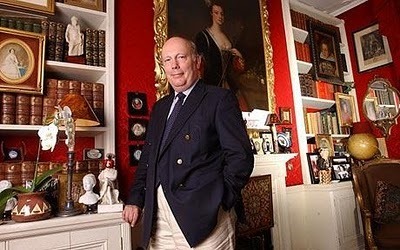 Born in Egypt, where his father was in the British Embassy, Fellowes grew up in England and attended Cambridge. In a 2005 interview Fellowes said, "When I was a young man, I came from the bottom end of the landed gentry. Now I get the glad hand; in those days I made up the extra --- the one who gets invited when someone else can't make it. At house parties I had the bedroom next to Nanny with the uncomfortable bed. When you're a minor player, you're in a better position to see people as they really are than if you're a grandee."
Born in Egypt, where his father was in the British Embassy, Fellowes grew up in England and attended Cambridge. In a 2005 interview Fellowes said, "When I was a young man, I came from the bottom end of the landed gentry. Now I get the glad hand; in those days I made up the extra --- the one who gets invited when someone else can't make it. At house parties I had the bedroom next to Nanny with the uncomfortable bed. When you're a minor player, you're in a better position to see people as they really are than if you're a grandee."After going to drama school, he was a "jobbing actor for ages" and appeared in more than 40 movies and TV shows, including Monarch of the Glen, in which Fellowes played the part of the titled, priviliged and somehow endearing Kilwillie. Other notable acting roles included the part of Claud Seabrook in the acclaimed 1996 BBC drama serial Our Friends in the North. He has twice notably portrayed George IV as the Prince Regent in the 1982 television version of The Scarlet Pimpernel and the 1996 adaptation of Bernard Cornwell's novel Sharpe's Regiment. In 1999, Fellowes played the Duke of Richmond in the Masterpiece Theatre production of The Aristocrats, based on the book by Stella Tillyard. He launched a new series on BBC One in 2004, Julian Fellowes Investigates: A Most Mysterious Murder, which he wrote and also introduced on screen.
Feeling in need of a Plan B, Fellowes turned to writing and worked for a while for BBC TV, where he adapted Little Lord Fauntleroy and the Prince and the Pauper for television. Subsequently he wrote a screenplay for Anthony Trollope's The Eustace Diamonds, which drew the attention of producer Bob Balaban, who was looking for a British society insider to write a screenplay for a murder mystery. "And so Gosford Park was born, and so was the rest of my life," explained Fellowes, who won the Oscar for Best Writing, Screenplay Written Directly for the Screen in 2002 for that film.
In addition to Gosford Park, Fellowes wrote the screenplay for Mira Nair's Vanity Fair (Starring Reese Witherspoon) and the book for the London and Broadway productions of Mary Poppins. He also wrote and directed Separate Lies, which he described in 2005 as "a French film in English, about middle-class people being unhappily married, which will doubtless be steamrollered in the Big, Bad World, but I love it and I loved making it, so I have no sad tales to tell."
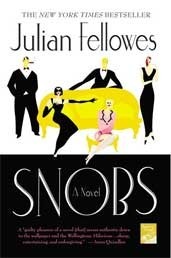 The year 2005 also saw his novel Snobs published, which focused on the social nuances of the upper class and concerned the marriage of an upper-middle class girl to a peer and became a Sunday Times Best Seller. In a 2005 interviews, Fellowes said, "At the risk of vanity, I would say the accuracy of the book was what irritated them most. Like politicians or show-folk, toffs usually shrug off any criticism of themselves in fiction by pointing out the inaccuracies which demonstrate that the author cannot have had a close view. One senior aristocrat was reported as having said, "The problem with Snobs is you can't fault it." An old pal telephoned with the greeting, "It's a wonder to me you have any friends left!" However, all in all, I would say more of them were amused to find their world in print than were offended. For which I am heartily grateful." 2008 saw the publication of his second novel, Past Imperfect, which also became a Sunday Times Best Seller.In the 1970s he also wrote romantic novels, using the names Rebecca Greville and Alexander Morant.
The year 2005 also saw his novel Snobs published, which focused on the social nuances of the upper class and concerned the marriage of an upper-middle class girl to a peer and became a Sunday Times Best Seller. In a 2005 interviews, Fellowes said, "At the risk of vanity, I would say the accuracy of the book was what irritated them most. Like politicians or show-folk, toffs usually shrug off any criticism of themselves in fiction by pointing out the inaccuracies which demonstrate that the author cannot have had a close view. One senior aristocrat was reported as having said, "The problem with Snobs is you can't fault it." An old pal telephoned with the greeting, "It's a wonder to me you have any friends left!" However, all in all, I would say more of them were amused to find their world in print than were offended. For which I am heartily grateful." 2008 saw the publication of his second novel, Past Imperfect, which also became a Sunday Times Best Seller.In the 1970s he also wrote romantic novels, using the names Rebecca Greville and Alexander Morant. 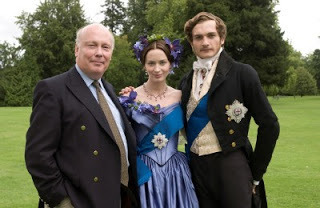
In 2006 and 2007, Fellowes was the host of the BBC TV panel game show "Never Mind the Full Stops." He wrote the screenplay for The Young Victoria, and has other screenplays to his credit, including Jonathan Strange and Mr. Norrell.
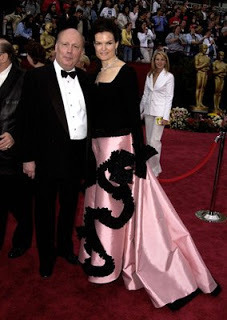 Last year, in response to a question about ways in which to beat the blues, Fellowes told The Telegraph, "If you're stuck in the city at a time of high stress, the best thing is to pop down to your local cemetery. I wrote quite a few of my early books in Brompton Cemetery, which is full of architectural curiosities. Highgate, of course, is remarkable – its most famous occupant is probably Karl Marx – and no visit to Paris is complete without a tour of Père Lachaise, the resting place of Balzac, Bizet, Proust, Seurat, Wilde and countless other names. Whichever cemetery you choose, there's always a chance you'll meet someone famous… or, rather, someone who was. These green spaces are quiet and reflective, and a good reminder that things could be a lot worse."
Last year, in response to a question about ways in which to beat the blues, Fellowes told The Telegraph, "If you're stuck in the city at a time of high stress, the best thing is to pop down to your local cemetery. I wrote quite a few of my early books in Brompton Cemetery, which is full of architectural curiosities. Highgate, of course, is remarkable – its most famous occupant is probably Karl Marx – and no visit to Paris is complete without a tour of Père Lachaise, the resting place of Balzac, Bizet, Proust, Seurat, Wilde and countless other names. Whichever cemetery you choose, there's always a chance you'll meet someone famous… or, rather, someone who was. These green spaces are quiet and reflective, and a good reminder that things could be a lot worse." Fellowes is married to Emma Kitchener, a great-niece of the first Lord Kitchener and a lady-in-waiting to Princess Michael of Kent.
Published on March 14, 2011 01:04
March 13, 2011
Behind the Scenes Tour - Drury Lane Theatre
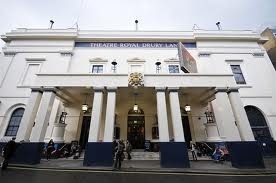
Through the Stage Door is the UK's first Interactive Theatre Tour at the Theatre Royal Drury Lane. Directed by Andrea Brooks with three professional actors, the history of The Theatre Royal Drury Lane is brought to vivid life as key characters, writers and actors from the theatre's 300 year old past take you back through time as you look around this famous theatre. Since its construction in 1663 the theatre has triumphed over tragedy, fire, bankruptcy and even murder.
The Theatre Royal in Drury Lane opened in 1663, soon after the Restoration when Charles II returned to the throne. This ended Parliament's puritanical rule which had seen all theatres in England closed, and the destruction of Shakespeare's Globe. Now in a new and more fun loving age, Thomas Killigrew formed the Kings Company and built the first Theatre Royal Drury Lane, an important symbol of Britain's theatrical reinvigoration following the barren years of puritan rule.
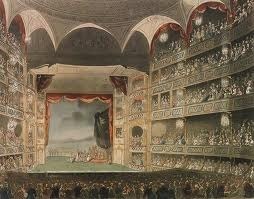
Since that first theatre there have been three more theatres built on the site of the original, in 1674, 1794 and 1812. The 1794 theatre was built by dramatist and radical MP Richard Sheridan. This was the biggest of all the Drury Lane theatres. It was in this theatre that an assassination attempt was made against George III . James Hadfield fired two shots at King George who was sitting in the royal box. Both missed their target. The would-be assassin was arrested, and George ordered the performance to continue. The 1794 theatre burned down in February 1809, a disaster which ruined Sheridan. There is a well known and oft told anecdote regarding Sheridan and the night of the fire, the following account is from The Lives of Wits and Humourists by John Timbs:
"On the night of the 24th of February, 1809, while the House of Commons was occupied with Mr. Ponsonby's motion on the conduct of the War in Spain, and Mr. Sheridan was in attendance, with the intention, no doubt, of speaking, the House was suddenly illuminated by a blaze of light; and the debate being interrupted, it was ascertained that Drurylane Theatre was on fire. A motion was made to adjourn; but Mr. Sheridan said, with much calmness, that "whatever might be the extent of the private calamity, he hoped it would not interfere with the public business of the country." He then left the House, and proceeding to Drury-lane, witnessed, with a fortitude which strongly interested all who observed him, the entire destruction of his property. . . It is said that as he sat at the Piazza coffee-house, during the fire, taking some refreshment, a friend of his having remarked on the philosophical calmness with which he bore his misfortune, Sheridan answered, `A man may surely be allowed to take a glass of wine by his own fireside.'
"Among his losses on the occasion there was one which, from being associated with feelings of other times, may have affected him, perhaps, more deeply than any that were far more serious. A harpsichord that had belonged to his first wife, and had long survived her sweet voice in silent widowhood, was, with other articles of furniture that had been removed from Somerset House, (Sheridan's official apartments,) to the theatre, lost in the flames. The cost of building of this vast theatre had exceeded 150,000 pounds; and the entire loss by the fire, including that of the performers, musicians, etc., was estimated at 300.000 pounds."
Theatre Royal Drury Lane is now owned by Andrew Lloyd Webber's Really Useful Company, and is used to stage musical theatre.
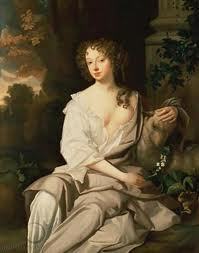 Nell Gwynne
Nell GwynneThe tour lasts approximately one hour, during which participants will meet characters such as the playwright Richard Sheridan, the great clown Grimaldi, the celebrated actress/mistress Nell Gwynne and many others who played an important role in the theatre's history.
Tour Times: 10.15am and 11.45am - Wednesday and Saturday
2.15pm and 4.15pm - Monday, Tuesday, Thursday, Friday
You can buy tickets online here.
Published on March 13, 2011 00:15
March 12, 2011
More Magnificence at the Yale Center for British Art, Part Two
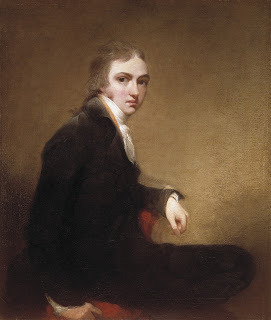 Victoria here again, effusing about my visit to New Haven CT to experience in person the delights of Thomas Lawrence: Regency Power and Brilliance. At left is a self-portrait painted in 1787-88, the earliest work in the exhibition, I believe. It certainly shows great technical ability and promise. Lawrence was only about eighteen at the time. According to the catalogue essay by Lucy Peltz (Curator of 18th-century Paintings, National Gallery, London), he wrote home at the time from London: "Excepting Sir Joshua, for the painting of a Head, I would risk my reputation with any painter in London." Amazing confidence for one so young. But he had been a prodigy since early youth, encouraged by his innkeeper father to sketch customers to the extent that young Tom was the family's primary support. He had occasional stretches of formal education at the Royal Academy, but his career outstripped almost all advice and pedagogy. By 1789, he was painting a portrait of the Queen at Windsor.
Victoria here again, effusing about my visit to New Haven CT to experience in person the delights of Thomas Lawrence: Regency Power and Brilliance. At left is a self-portrait painted in 1787-88, the earliest work in the exhibition, I believe. It certainly shows great technical ability and promise. Lawrence was only about eighteen at the time. According to the catalogue essay by Lucy Peltz (Curator of 18th-century Paintings, National Gallery, London), he wrote home at the time from London: "Excepting Sir Joshua, for the painting of a Head, I would risk my reputation with any painter in London." Amazing confidence for one so young. But he had been a prodigy since early youth, encouraged by his innkeeper father to sketch customers to the extent that young Tom was the family's primary support. He had occasional stretches of formal education at the Royal Academy, but his career outstripped almost all advice and pedagogy. By 1789, he was painting a portrait of the Queen at Windsor.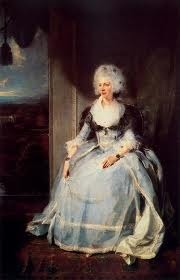 Charlotte of Mecklenburg-Strelitz (1744-1818) married King George III in 1761 when she was seventeen years old. She bore him fifteen children. When she sat for Lawrence, rather unwillingly it seems, she was about 45 years old and disturbed by the King's recent bouts of peculiar illness, both mental and physical. The events of 1789 in France did not help. Queen Charlotte had been painted by many artists, including Allan Ramsay,
Charlotte of Mecklenburg-Strelitz (1744-1818) married King George III in 1761 when she was seventeen years old. She bore him fifteen children. When she sat for Lawrence, rather unwillingly it seems, she was about 45 years old and disturbed by the King's recent bouts of peculiar illness, both mental and physical. The events of 1789 in France did not help. Queen Charlotte had been painted by many artists, including Allan Ramsay, Benjamin West, Johann Zoffany, Reynolds, and Gainsborough. Neither the Queen nor the King liked the Lawrence and never paid him. But it was highly praised at the 1790 Royal Academy exhibition and is now in the collection of the National Gallery, London.
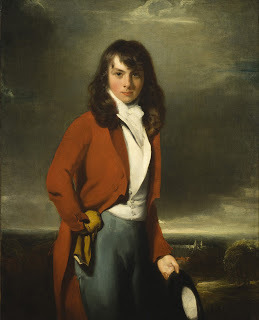 Arthur Atherley (1771-1844) was painted in 1792 when he was about age twenty. Exhibited simply titled "Portrait of an Etonian," the painting was said by one reviewer to be comparable to Sir Joshua (Reynolds), certainly high praise for Lawrence, the relative newcomer to the London art scene.
Arthur Atherley (1771-1844) was painted in 1792 when he was about age twenty. Exhibited simply titled "Portrait of an Etonian," the painting was said by one reviewer to be comparable to Sir Joshua (Reynolds), certainly high praise for Lawrence, the relative newcomer to the London art scene. 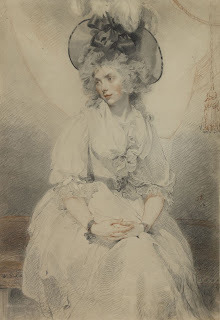 Mary Hamilton, Later Mary Denham, d. 1837
Mary Hamilton, Later Mary Denham, d. 1837graphic and red and black chalk, executed in 1789
Mrs. Hamilton read to Lawrence and her husband, artist William Hamilton, while they drew antique statues in the evening. This drawing was probably a gift to the couple, though Lawrence sent it to the RA for exhibition in 1789. As Lawrence's star rose, however, Hamilton's career did not flourish and the two men grew apart.
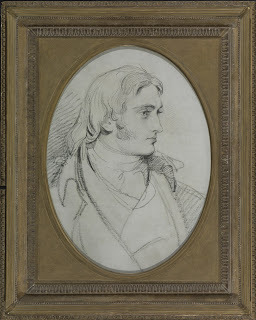 William Lock, the Younger (1767-1847), drawn in black chalk on canvas, sometime between 1795 and 1800.
William Lock, the Younger (1767-1847), drawn in black chalk on canvas, sometime between 1795 and 1800.One of the strengths of this exhibition is the excellent selection of drawings by Lawrence, which are far less familiar then his dazzling oil portraits, but equally pleasing to the visitor.
Lock was part of the "charmed circle" of families that Lawrence became part of, including the Angersteins and Locks. He drew and painted many members of the families and particularly their children.
William Lock's sister Amelia married John Angerstein in 1799.
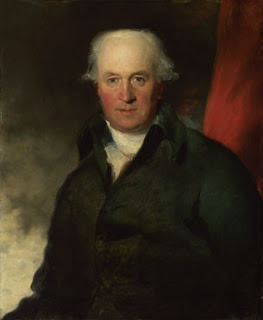 This portrait of John Julius Angerstein (1796-1823) was painted in 1790. Angerstein was a wealthy insurance broker in the City of London and one of Lawrence's earliest supporter, as patron, friend and banker. He was important to the development of Lloyd's of London, and was a prominent art collector. He was born in Russia, and it has been rumored that he was the illegitimate son of Catherine the Great, but it is more likely that he was of much more modest birth. Nevertheless, he acquired a considerable fortune. Lawrence advised Angerstein on some of his old master purchases. After his death, the collection was purchased by the government to be part of the new National Gallery which now sits above Trafalgar Square.
This portrait of John Julius Angerstein (1796-1823) was painted in 1790. Angerstein was a wealthy insurance broker in the City of London and one of Lawrence's earliest supporter, as patron, friend and banker. He was important to the development of Lloyd's of London, and was a prominent art collector. He was born in Russia, and it has been rumored that he was the illegitimate son of Catherine the Great, but it is more likely that he was of much more modest birth. Nevertheless, he acquired a considerable fortune. Lawrence advised Angerstein on some of his old master purchases. After his death, the collection was purchased by the government to be part of the new National Gallery which now sits above Trafalgar Square.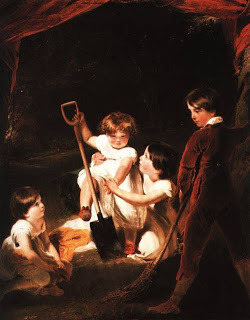 These Children of John Angerstein, painted in
These Children of John Angerstein, painted in 1807, were the grandchildren of John Julius Angerstein, above. The choice of pose is unusual in that wealthy children of privileged families are rarely portrayed with shovel and broom. The catalogue essay speculates that the elder Angerstein's philanthropic interest in children would promote, "the hoped-for future for children...the right to play outdoors and enjoy autonomy, and to influence one another through action and word. If a child sweeps as young John Julius Angerstein does, he should do so for enjoyment. In this way the children embody the promise of philanthropy for future generations."
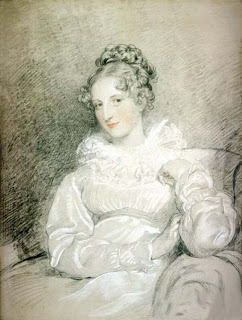 Countess Therese Czernin (1798-1896), drawn in 1819, was the daughter of an Austrian general. Apparently it remained in the family of the countess and was not known until it was sent to an auction in 1985, where it was revealed as the work of Lawrence. It is now owned by a private collection. It makes one wonder what other treasures might be lurking in some old castle attic. Another work by Lawrence? A letter from Jane Austen? A lover's eye ring? If you find anything in your castle, please send word.
Countess Therese Czernin (1798-1896), drawn in 1819, was the daughter of an Austrian general. Apparently it remained in the family of the countess and was not known until it was sent to an auction in 1985, where it was revealed as the work of Lawrence. It is now owned by a private collection. It makes one wonder what other treasures might be lurking in some old castle attic. Another work by Lawrence? A letter from Jane Austen? A lover's eye ring? If you find anything in your castle, please send word.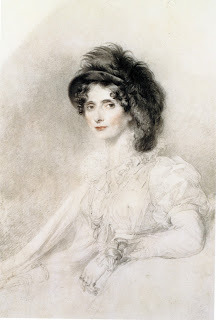
Several years ago, I stayed at the National Trust Hotel that is part of Ickworth, an estate in Suffolk, built by the Earl Bishop, Frederick Hervey (1730-1803), 4th Earl of Bristol and Bishop of Derry (see our post of 3/9/11). He built his remarkable house in the last decades of the 18th century. One of his daughters was Lady Elizabeth Hervey (1757-1824), who married John Foster in 1776. After having two sons with Foster, Bess left him and in 1782 became the close friend and confidante of Georgiana, Duchess of Devonshire. She enjoyed a rather warm relationship with William Cavendish (1748-1811), 5th Duke of Devonshire, as well and bore the duke two children who were raised with the three legitimate Cavendish children. Speculating on the precise nature of this menage a trois tickles our imagination. After Georgiana died in 1806, Lady Elizabeth became the 5th duke's second wife in 1809. He did not survive long, dying in 1811, but she lived on as the Duchess of Devonshire until 1824. If she indeed resembled this portrait drawn by Lawrence when she was age 63 or so, one might understand what kind of charisma the lady had.
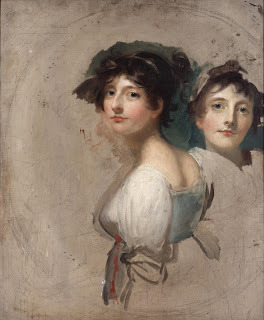 Occupying an interesting point between chalk drawings and a finished painting is this unfinished portrait of Emilia, Lady Cahir, later Countess of Glengall (1776-1836) done in 1804-05. There are three heads here, though it is difficult to see the one on the left. It is visible in the exhibition if you look closely. You might be able to make out the lips and the nose of the left-most head just below and to the left of the center head's chin.
Occupying an interesting point between chalk drawings and a finished painting is this unfinished portrait of Emilia, Lady Cahir, later Countess of Glengall (1776-1836) done in 1804-05. There are three heads here, though it is difficult to see the one on the left. It is visible in the exhibition if you look closely. You might be able to make out the lips and the nose of the left-most head just below and to the left of the center head's chin.The work was perhaps done at a house party at Bentley Priory where Emilia and Thomas Lawrence both played roles in theatricals. Bentley Priory belonged to the Marquess of Abercorn and was the scene of many country house theatricals.
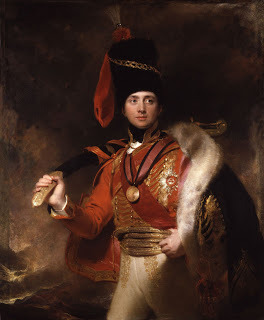 Charles William (Vane-)Stewart, later 3rd Marquess of Londonderry (1778-1854) was painted in 1812. The catalogue says it is "celebrated as one of the ultimate icons of British military portraiture."
Charles William (Vane-)Stewart, later 3rd Marquess of Londonderry (1778-1854) was painted in 1812. The catalogue says it is "celebrated as one of the ultimate icons of British military portraiture."As Undersecretary for War and one of Wellington's Adjutant-Generals, Stewart cuts a glamorous and colorful figure. His uniform is of a cavalry officer, a dashing hussar, with the details and medals highlighted. The portrait also represents a turning point for Lawrence, bringing him an introduction to the Prince Regent and eventual commissions for the Waterloo Chamber portraits (detailed in my next post on the Yale exhibition).
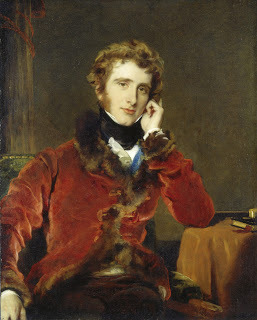 George James Welbore Agar-Ellis, later 1st Lord Dover (1797-1833), painted a decade later in 1823-24, shows Lawrence extending his bravura palette of colors into the world of the civilian male. He was particularly fond of Agar-Ellis who proposed that Parliament purchase the collection of the Late J.J. Angerstein (see above) for the nucleus of a national collection.
George James Welbore Agar-Ellis, later 1st Lord Dover (1797-1833), painted a decade later in 1823-24, shows Lawrence extending his bravura palette of colors into the world of the civilian male. He was particularly fond of Agar-Ellis who proposed that Parliament purchase the collection of the Late J.J. Angerstein (see above) for the nucleus of a national collection.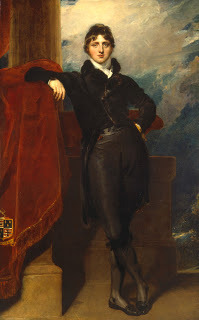 To complete this trio of handsome Regency heroes, the portrait at left, again over life size, seems to sum up everything about an aristocrat in his element: Lord Granville Leveson-Gower (1773-1846), later 1st Earl Granville, whose expression, almost a smirk, is absolutely perfect. He was painted in 1804-06 when he was serving as British Ambassador to Russia. Later he was ambassador France.
To complete this trio of handsome Regency heroes, the portrait at left, again over life size, seems to sum up everything about an aristocrat in his element: Lord Granville Leveson-Gower (1773-1846), later 1st Earl Granville, whose expression, almost a smirk, is absolutely perfect. He was painted in 1804-06 when he was serving as British Ambassador to Russia. Later he was ambassador France.A younger son of the 1st Marquess of Stafford, he married Lady Harriet Elizabeth Cavendish (1785-1862), known as Harry-O, daughter of the 5th Duke of Devonshire and his wife, Georgiana, in 1809. They had five children and raised the two by-blows Granville fathered with his mistress, Harry-O's aunt, Lady Harriet Bessborough. He was raised to the peerage as a Viscount in 1815 and to the title of Earl Granville in 1833.
This painting of Lord Granville Leveson-Gower dates from 1804-1809 and is part of the YCBA's Paul Mellon Collection
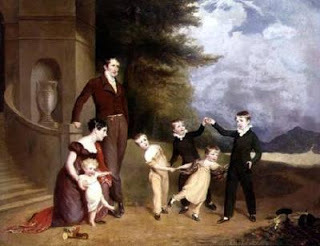
Though it might not sound like an auspicious beginning for a marriage, with Granville's several affairs known to Harry-O, apparently it grew into a strong relationship, as both partners also grew in religious fervor -- along with many of the formerly-loose members of Regency society as the years passed into Victorian sobriety and admiration for moral rectitude. At right, a painting of the happy Granville family by Thomas Phillips. Definitely NOT a Lawrence and not in the exhibition.
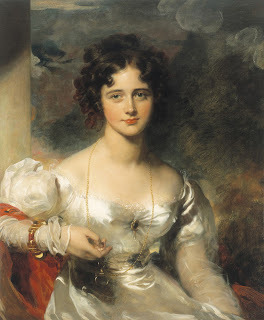 Rosamund Hester Elizabeth Pennell Croker, later Lady Barrow (1809-1906) was painted by Lawrence in 1826. When exhibited at the RA in 1827, it was highly praised and often surround by admiring patrons.
Rosamund Hester Elizabeth Pennell Croker, later Lady Barrow (1809-1906) was painted by Lawrence in 1826. When exhibited at the RA in 1827, it was highly praised and often surround by admiring patrons. In the catalogue essay, Cassandra Albinson writes, "Lawrence felt one could judge artists' skill by how they executed white satin, as in the dress depicted here." I would say this one is very skillful!
Notice that she lived a very long life, reaching the age of 96 or 97.
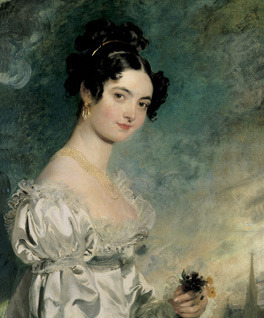
Lady Selina Meade, later Countess of Clam-Martinics
(?1797-1872 ) was painted in Vienna in 1819 and exhibited at the RA the next year. Observers called attention to the highlights of her pearl earrings and gold headband as perfect compliments to her beauty. Note also the excellence of the white satin. The catalogue contends she had been courted by Lord Granville Leveson-Gower but in 1821 she married an Austrian, Karl Graf von Clam-Martinics.
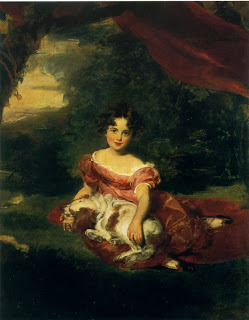
Julia Beatrice Peel (1821-93) was painted in 1826-28 when she was about 6 years old. Another adorable child, like we saw in my earlier post on this exhibition. One of Lawrence's true gifts was his ability to portray the beauty and innocence of children. Julia Peel was the daughter of Sir Robert Peel (1788-1850) who was Home Secretary at the time of the portrait. Later he served as Prime Minister 1834-35 and again 1841-45. He founded the London police force; they are still called Bobbies, after him. Julia married George Augustus Frederick Child Villiers, who became the 6th Earl of Jersey, so she was another Lady Jersey. This portrait, like that of Leveson-Gower, is shown only at Yale.
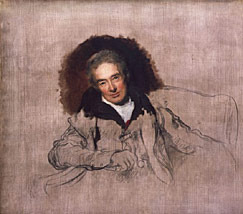
William Wilberforce (1759-1833) is the man who campaigned for more than twenty years to end the slave trade, which was accomplished in 1807. In 2006, there was an excellent movie about his life, titled Amazing Grace. I recommend it; though it has a few historical inaccuracies, the gist is correct. Making up for any deficiencies in the facts are the excellent performances by a fine cast: Ioan Gruffudd as Wilberforce, Romola Garai as Barbara Spooner, Benedict Cumberbatch as William Pitt the Younger, Albert Finney as John Newton (who wrote the famous hymn), Michael Gambon as Charles James Fox (who actually died before the bill passed), and Rufus Sewell as Thomas Clarkson.
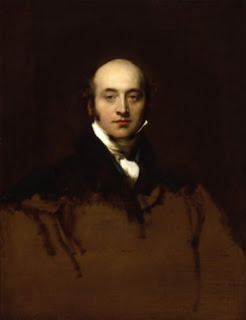
Here is a final self portrait by Lawrence, painted in 1825, five years before his death. Like the Wilberforce and many other of his canvasses, it was unfinished. Lawrence left a huge number of semi-completed pictures in his Russell Square studio some of which had already been paid for. He also left numerous debts.
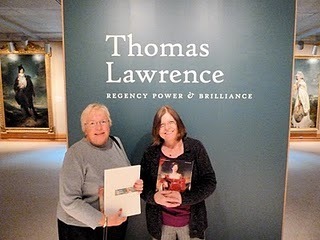
I would never presume to be able to divide the pictures into the two categories of the Power and the Brillliance, but I almost have done so in this post -- the Brilliance. And in my third post, I will concentrate on the Power. Stay tuned. And just to remind you of how lucky I was to have a fellow writer as a companion, here is a repeat of us in front of the exhibition, Diane Gaston on the right. [image error]
Published on March 12, 2011 02:00
Kristine Hughes's Blog
- Kristine Hughes's profile
- 6 followers
Kristine Hughes isn't a Goodreads Author
(yet),
but they
do have a blog,
so here are some recent posts imported from
their feed.



